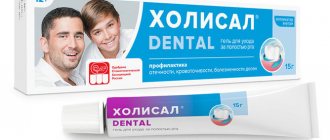Sore throat is one of the most common infectious diseases that affects our tonsils (tonsils). In the medical literature you can find another name for this diagnosis: acute tonsillitis. Purulent sore throat in an adult is an infectious disease that is provoked by pathogenic microorganisms, namely hemolytic streptococci of groups A and B, and less commonly staphylococci.
The disease is extremely contagious. The disease is transmitted not only by airborne droplets. You can become infected through contact when sharing the same dishes or towels with a sick person. Both children and adults are susceptible to the disease.
This disease has a clearly defined seasonality and most often appears in the autumn-spring period.
Despite the fact that many people treat the diagnosis of “acute tonsillitis” as something natural and commonplace, nevertheless, this disease is not as simple as it seems. If there is a careless attitude towards it, when proper treatment of purulent sore throat in adults is not carried out, severe complications can develop, involving associated organs (kidneys, joints and myocardium - heart muscle) in the chronic inflammatory process.
Structure of the tonsils
The palatine tonsils, or tonsils, are an important organ of the human immune system. The tonsils are located in the oral cavity on both sides of the pharynx. The tonsils are shaped like an almond (hence the name “almond”) and range in size from one to four centimeters in diameter. The tonsils are endowed with a protective function. They are a kind of barrier to bacteria entering the body through airborne droplets, as well as through food intake. The structural features of the tonsils and the functions they perform are directly related to the appearance of tonsillitis plugs in the throat.
Make an appointment right now!
Call us by phone or use the feedback form
Sign up
On the surface of the tonsils, winding canals and openings are visible - lacunae and crypts.
When viruses from the outside enter the mouth, leukocytes in the tonsils are activated and begin an intensified process of forming antibodies that fight the “enemy.” At the same time, a signal is sent to all organs of the immune system, and the body comes into “combat readiness”.
What is tonsillitis?
Tonsillitis is an inflammatory process in the tonsils. The disease can be acute or chronic. The acute form is better known as tonsillitis. In chronic cases, periods of exacerbation (inflammation of the tonsils) are replaced by a period of remission (calm). Most often, the disease occurs in children 5-15 years old, although adults are also susceptible to the disease. The tonsils in children are larger than in adults. The palatine tonsils reach their maximum size by the age of 7, and then begin to shrink. Constant viral attacks on the tonsils lead to tonsillitis. Chronic tonsillitis most often acts as a complication after an infectious disease (sore throat, caries, etc.). The chronic form of the disease, according to statistics, occurs in 5% of adults and 11% of children. That is, chronic tonsillitis is a common disease. Tonsillitis plugs on the tonsils often appear with chronic tonsillitis.
Ulcers with fever
Plaque on the tonsils, accompanied by signs of intoxication, indicates a viral or bacterial infection. Ulcers in the throat with fever most often occur with sore throat, as well as scarlet fever, the causative agents of which are streptococcus, staphylococcus, and klebsiella.
The disease begins with an increase in temperature, the appearance of painful sensations in the oropharynx during swallowing and in the normal state. In the catarrhal form of tonsillitis, the tonsils are enlarged, loosened, and covered with transparent mucus. The tongue is covered with a white coating, and painful sensations are observed when swallowing. Treatment of angina must be comprehensive. It includes the use of antibacterial drugs, symptomatic therapy, as well as means for local treatment of the throat.
Abscesses with fever can also occur with infectious mononucleosis and adenoviral infection. Both of these diseases are very acute. Initially, the temperature rises, and then other symptoms appear.
Diseases such as herpetic sore throat and aphthous stomatitis can provoke the formation of ulcers in the throat. Sore throat occurs when the body is infected with enteroviruses and is similar in symptoms to the course of herpes. With stomatitis, whitish ulcers form that completely cover the entire pharynx and oral mucosa.
Causes of chronic tonsillitis
The chronic form of tonsillitis often develops as a complication after a sore throat. Many patients try to cure a sore throat on their own and take medications uncontrollably. Some, having received doctor’s recommendations, do not follow the instructions and finish the course of taking antibacterial drugs earlier than expected, noticing an improvement. This is a huge mistake! Untreated sore throat causes the disease to enter the chronic stage and the formation of tonsillitis with purulent plugs. The main causative agents of the disease are streptococci and staphylococci.
Exacerbation of tonsillitis is favored by:
- chronic inflammatory process (sinusitis, caries, sinusitis, etc.);
- proliferation of adenoids;
- deviated nasal septum;
- damage to the tonsils;
- hypothermia;
- weak immunity.
Why do traffic jams occur with tonsillitis?
The main factor in the formation of purulent plugs on the tonsils is the constant presence of a focus of inflammation, provoked by viruses. There are always bacteria in the human mouth - they are not dangerous to health. Once in the gaps, they are killed by immune cells. The tonsils of a healthy person are capable of self-cleaning - dead microorganisms are removed from the lacunae and enter the stomach with saliva, where they are destroyed under the influence of gastric juice.
But as soon as dangerous viruses enter the body, a large number of leukocytes are sent to fight them, the mucous membrane of the tonsils swells, and self-cleaning of the lacunae under such conditions becomes difficult. Dead bacteria and leukocytes begin to accumulate in the tonsils - purulent-caseous formations appear. If you do not consult an otolaryngologist in time and do not begin treatment for purulent tonsillitis plugs, the process can become irreversible and lead to the destruction of the tonsils.
Purulent formations and chronic tonsillitis
In the chronic form of the disease, inflammation in the tonsils does not completely disappear, but only subsides for a while. Bacteria are always present in the lacunae of the tonsils, and the increased formation of a large number of leukocytes does not stop. Since the chronic form is characterized by the absence of pronounced signs of the disease, the appearance of purulent plugs goes unnoticed by the patient. White blood cells surround the bacteria, and a purulent formation appears. Over time, substances containing calcium and magnesium accumulate in them. As a result, the plugs harden.
Among the reasons for the formation of traffic jams are:
- diseases of the nasal cavity that are chronic (for example, sinusitis) - some of the bacteria from the nose certainly gets into the throat;
- lack of proper oral hygiene - here bacteria are constantly present and when immunity decreases, they enter the tonsils; food debris can also get stuck in the gaps and become “material” for the hardening of purulent masses;
- weak immunity - a person is unable to cope with the infection on his own, and the disease becomes protracted or chronic;
- damage to the tonsils - infection can easily get into the wound. Often it is the site of injury that becomes the location of a new purulent formation.
Symptoms of purulent plugs in the throat
Traffic jams are a factor by which chronic tonsillitis can be recognized. Therefore, when traffic jams appear, all the signs of this chronic disease are present. The following symptoms can be identified during an exacerbation of tonsillitis.
Constantly recurring sore throats - if there is inflammation in the tonsils, then this is not an indicator of chronic tonsillitis. But if a person is susceptible to the disease more than two or three times a year, then we can confidently say that we are dealing with a chronic form of the disease.
Friends! Timely and correct treatment will ensure you a speedy recovery!
The next symptom is redness and swelling of the palatine arches, to which inflammation from the tonsils can spread. Adhesions can form between the palatine arches and the tonsils - they seem to stick together with each other.
Enlarged lymph nodes are another sign of the disease. The manifestation of tonsillitis is accompanied by elevated body temperature. In the chronic form, a temperature of 37°C can last from several days to several weeks. The patient feels constant fatigue, lethargy, and performance decreases. All these are signals of adverse changes occurring in the body.
Gargling to cleanse tonsils
Rinsing is a universal treatment that can be used to get rid of small pustules. Also, rinsing consolidates the procedure of mechanical cleansing of the tonsils from pus. If, at the beginning of the disease, the feeling of a slight sore throat is drowned out by several gargling procedures, you can suppress the disease in its very beginning.
It is best to gargle with a warm mixture. When rinsing, it is very important to observe the frequency of procedures. After all, when you gargle, you cleanse the mucous membrane of bacteria and viruses that cause pain. You need to gargle every 2-3 hours if you want to quickly cure a sore throat. For greater effect, you can alternate solutions. Here are some liquid recipes for effective gargling.
- One of the most effective folk recipes is gargling with a decoction of chamomile and calendula. Plants can be fresh or dried. You can collect them yourself or buy them at the pharmacy. Place two tablespoons of chopped chamomile and calendula herbs into a saucepan and pour a liter of boiling water. Cook the mixture over low heat for about half an hour, then cover with a lid and let it cool a little and brew. When the broth is warm enough, you need to strain it and gargle with it. Chamomile perfectly soothes the mucous membranes, relieves pain and swelling. Calendula is a herbal antiseptic that destroys bacteria and germs.
- You can gargle with so-called “sea water,” especially since the ingredients for this medicine can be found in every home. For a glass of warm water you will need a teaspoon of salt, half a teaspoon of soda and a few drops of iodine. Mix the prepared solution thoroughly and gargle with it every two hours. It relieves pain well, heals wounds and prevents the emergence of new inflammatory processes.
- If there are severe ulcers and many small pustules on the mucous membrane of the throat, garlic gargling will help you. Two or three cloves of garlic need to be grated on a fine grater and pour a glass of boiling water. Let it cool a little, and then gargle with this mixture no more than three times a day. This remedy is quite effective, but it should not be abused, because it can burn the mucous membrane.
- Aloe and Kalanchoe leaves have a powerful anti-inflammatory effect. To prepare a rinse solution, you need to grind the leaves of an adult plant that is at least three years old. Squeeze the crushed leaves through clean gauze and get a tablespoon of healing juice. Dilute the plant juice with a glass of water and gargle with this mixture. Aloe and Kalanchoe relieve swelling of the tonsils and fight inflammation in the ulcers.
- If we talk about medical rinses, then furatsilin solution, chlorophyllipt, hexoral solution, chlorhexine, miramistin will help here. Any antiseptic you have in your home can help relieve your pain.
If the disease is infectious in nature, comprehensive treatment must be carried out. Along with mechanical cleansing of the tonsils and gargling, you need to take antibiotics that will suppress the infection inside the body. Competent treatment and a thorough approach will help you cure a sore throat in a few days.
how to gargle with calendula tincture
Symptoms of purulent plugs in the throat
The first sign is a feeling that there is something in the throat: like a lump; A dry cough may accompany these unpleasant sensations. The patient has difficulty swallowing and has a sore throat.
Severe pain in the throat is accompanied by a putrid odor from the mouth, which cannot be muffled even with the help of toothpastes. This smell is the result of the activity of bacteria accumulated in traffic jams. Caseous formations are also visible upon visual inspection - curdled tubercles of a white-yellow hue are immediately noticeable on the tonsils. It happens that the pustules are not immediately visible, but as soon as you press on the surface of the tonsil, for example, with your tongue, these white-yellow tubercles begin to appear.
Blockages in the tonsils can bring a lot of unpleasant and even dangerous consequences to the patient: if the infection travels with the blood or lymph flow further through the body, it can cause problems with the heart, kidneys and joints. In order not to have to treat complications from tonsillitis, it is necessary to get an appointment with an otolaryngologist in a timely manner and begin treatment for tonsillitis with purulent plugs.
Consequences of purulent sore throat
Acute tonsillitis can occur with complications. They are usually divided into local and general.
Local complications:
- paratonsillar abscess - an abscess that forms outside the tonsil when infection penetrates into the surrounding tissue;
- acute otitis media – inflammation of the middle ear;
- acute laryngitis - inflammation of the larynx;
- cervical lymphadenitis – inflammation of the lymph nodes1.
General complications occur more often with streptococcal sore throat4, these include:
- rheumatism;
- rheumatoid arthritis;
- myocarditis;
- polyarthritis;
- glomerulonephritis and pyelonephritis;
- pneumonia and others1.
Up to contents
Treatment of tonsillitis plugs
The appearance of plugs indicates long-term inflammation occurring in the body, so the removal of purulent plugs must be combined with measures to treat chronic tonsillitis. Chronic tonsillitis should be treated by a competent otolaryngologist. Only an ENT doctor knows how to treat tonsillitis plugs effectively and safely. There is no need to try to get rid of pustules on your own at home. Many patients begin to put pressure on the tonsils, scraping off the “plaque” with a spoon and other improvised means. But this measure is ineffective - pus is removed only from the surface, but this is only the tip of the iceberg, the main problem is inside. Such inept actions often lead to injury to the tonsils, which will only provoke the appearance of new caseous formations.
Features of treatment
To determine how to remove ulcers in the throat, it is imperative to conduct a comprehensive diagnosis. For candidiasis, antifungal treatment is required. The drug is selected strictly individually, it all depends on the type of fungus. In addition, gargling with a soda solution and irrigating the throat cavity are recommended.
How to remove ulcers in the throat with a sore throat is of interest to many people, since they cause a lot of inconvenience and lead to an even greater deterioration in well-being. When tonsillitis occurs, antibacterial therapy is prescribed. Additionally, you need to take vitamins that help boost immunity, as well as probiotics to restore intestinal microflora.
Conservative method of removing tonsillitis plugs
Conservative treatment consists of:
- Treatment with medications (antibiotics and the duration of treatment is prescribed directly by the ENT doctor. Treatment of chronic tonsillitis should begin at the time of exacerbation, not remission. As a rule, the patient is prescribed the drugs “Amoxicillin”, “Amoxiclav”, “Summamed”, “Azithromycin”, etc. .).
- Gargling (solutions of furatsilin, soda, decoctions of chamomile, St. John's wort, string, from pharmaceutical products - Miramistin, Rotokan, etc. are excellent).
- Inhalations (as agreed with the doctor).
- Rinsing the lacunae of the tonsils (the most effective method for removing purulent accumulations. Performed only by an otolaryngologist. Rinsing is carried out using a syringe or a TONZILLOR device.
When carrying out a course of rinsing, the patient's condition significantly improves, the tonsils look healthier, and are cleared of purulent accumulations.
With chronic tonsillitis, the period of remission of the disease increases.
Treatment of sore throat
Depending on the severity of the patient’s condition, treatment of angina occurs under the supervision of a doctor at home or in a hospital.
Bed rest is mandatory, a gentle dairy-vegetable diet enriched with vitamins, and plenty of warm drinks are recommended. For bacterial sore throat, broad-spectrum antibiotics are prescribed. If the disease is caused by streptococcus, penicillin drugs are used. In case of severe intoxication syndrome, intravenous infusion of glucose-saline solutions is performed. Non-steroidal anti-inflammatory drugs are used as antipyretics and pain relievers.
For sore throat, gargling with alkaline and water-salt solutions and irrigating the pharynx with painkillers and antiseptics are recommended. The use of drugs in the form of a spray for the treatment of sore throat is possible only in adults and children over 3 years of age. With the development of purulent complications of the disease, hospitalization of the patient followed by surgical intervention is required.
Author:
Pugonina Tatyana Alekseevna, Therapist
Surgery
Tonsillectomy - removal of the tonsils - is the most radical way to get rid of the problem. It is used in the most extreme cases, when conservative methods do not bring the desired relief, and the indications for surgery must be quite serious. Before removing tonsils, you need to carefully weigh everything and first try a full range of conservative treatment measures. By removing the tonsils, you are deprived of a natural natural barrier against viruses and infections. You need to fight to preserve your tonsils to the last!
Tonsils are removed using a scalpel, laser or liquid nitrogen. Your ENT doctor will definitely tell you about all the intricacies and consequences of tonsillectomy.
Traditional medicine and preventive measures
Treatment with folk remedies for removing accumulated pus is not entirely effective - plugs located deep in the tonsil cannot be removed. With their help, you can only soften the surface of the plugs to facilitate their rejection and use herbal decoctions when gargling and disinfecting it.
To reduce the risk of traffic jams, you need to follow some simple tips:
- carefully monitor oral hygiene;
- treat sore throat and inflammation in the nose and mouth in a timely manner: sinusitis, frontal sinusitis, caries, stomatitis;
- avoid hypothermia;
- for chronic tonsillitis, follow the recommendations of your ENT doctor, do not forget about preventive complexes of physiotherapy and tonsil rinsing;
- Strengthen your immune system and try to lead a healthy lifestyle.
Treatment at the ENT Clinic of Doctor Zaitsev
Many years of experience of our doctors allows us to say with confidence that treating chronic tonsillitis is our specialty. The modern equipment of the clinic allows for effective and safe manipulations to treat tonsillitis and remove purulent plugs. Washing of the tonsils is carried out using all methods known in practice, including using a modified TONSILLOR nozzle, which has no analogues in other medical institutions. This is the know-how of our clinic. The modified attachment is much more effective than the usual one, completely safe, its use does not cause pain to the patient and is suitable even for small children.
Please make an appointment and come. We will be happy to help you.
Washing of the palatine tonsils in a clinical setting
Moscow clinics offer patients 2 highly effective options for hardware cleaning of the tonsils:
- vacuum, using the Tonsilor device;
- deep washing, combining hardware cleaning with phonophoresis and ultrasound.
Both methods help not only to cure the acute stages of ENT diseases, but also to get rid of chronic tonsillitis.
Vacuum rinsing of tonsils
The hardware method of cleansing the tonsils is a procedure that brings discomfort to the patient. To reduce pain, an anesthetic is used (usually the drug Lidocaine).
The duration of the manipulations is up to 10 minutes.
The procedure flow is as follows:
- the patient is asked to take a sitting position, tilt his head down, stick out his tongue;
- a special device with which the device is equipped is applied to the patient’s lymphoid accumulations;
- Using a vacuum, purulent deposits are removed from the ducts.
The course of therapy usually includes up to 10 rinses (in difficult cases, treatment is extended for another 5 procedures). After recovery, to achieve a prolonged effect, experts recommend repeating the vacuum cleansing procedure after 12 months.
You can see how the treatment procedure occurs in the video:
Contraindications to the use of this method in treatment regimens are: pregnancy, oncopathologies, retinal detachment, atherosclerosis, pulmonary tuberculosis.
Ultrasonic exposure
Excellent results in the treatment of tonsillitis are shown by deep cleansing of lymphoid accumulations. The liquefaction of purulent accumulations and the death of pathogens is caused by ultrasound (frequency - 26.5 kHz). The process is complemented by the introduction of medicinal drugs into the lymphoid tissue (phonophoresis). Before carrying out the procedure, you should watch a video about the main stages of Tonsilor therapy:
Timely treatment of inflammatory diseases of the ENT organs significantly reduces the risk of pathologies. An integrated approach will allow you to completely get rid of problems
- not only washing, but also taking drugs that stabilize the immune system, as well as hardening.










